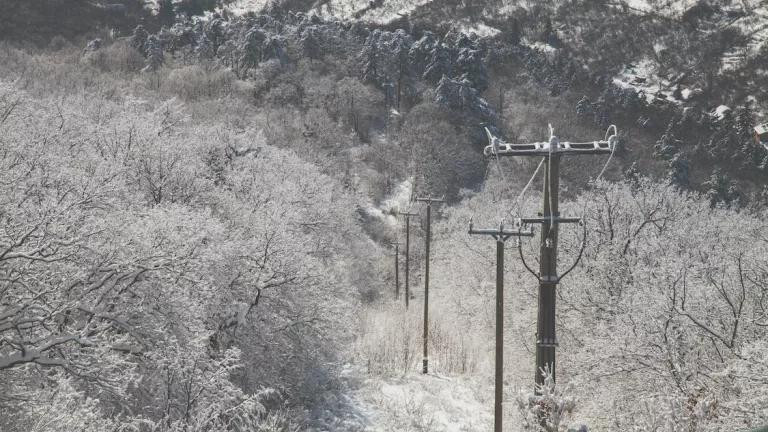It’s Time for PJM to Go Bold on Transmission
Nothing is preventing PJM from beginning transmission planning before the leaves turn.

Sometimes, everything lines up to make great things possible
Tom Skarbek-Wazynski
PJM’s transmission planning badly needs updating to keep up with a changing grid. PJM knows this and has been working for about a year on improvements. That work was mostly finished by the end of 2023, and PJM hoped to begin its new “Long-Term Regional Transmission Planning” (LTRTP) earlier this year. That has not happened. Instead, fossil fuel interests have stalled and delayed the new process, most recently managing to put off even voting on it until June. They have overplayed their hand. Next week, FERC (Federal Energy Regulatory Commission) will issue an order that will almost certainly go beyond what’s in LTRTP. Rather than continuing to bicker over a proposal that’s been overtaken by events, PJM should leverage the work it’s already done to immediately and unilaterally begin planning that will meet FERC’s new standards.
On Monday, FERC will issue its long-awaited order on transmission planning. While we don’t know exactly what the order will say, we have a good idea of its general outline. FERC will speak to three main issues: scenario planning, benefit analysis, and cost allocation. Scenario planning will cover how transmission providers develop the vision of the future they plan for, focusing on load growth and new renewables while retiring fossil plants. Benefit analysis will detail how to assess the value of new transmission: economic benefits from lower cost power, reliability, and possibly others. Cost allocation is about who pays for transmission, so it will probably be the most contentious part of the order.
We can’t overstate how important this order could be. If FERC is ambitious on scenarios and benefit analysis, the order will start the nationwide process of planning for the grid of the future. Quite simply, FERC’s Monday order could fill one of the critical missing links we need to start the energy transition at scale.
Transmission planning is a long process. As PJM envisions it now, each planning cycle would take three years, roughly corresponding to the three main aspects of the expected FERC order. The first year is spent developing scenarios so that we have a clear set of visions for what the future might look like. The second year analyzes those scenarios and possible transmission projects, and the third year is devoted to deciding which projects to build and contracting construction.
This all means that scenario development is separable from the rest of the transmission planning process and can proceed while details of benefit analysis and cost allocation are hammered out. The goal of scenario planning is to come up with the most accurate possible predictions of what the future electrical system will look like. Since accuracy is the goal here, that process is largely independent of later decisions on what transmissions we should build and how to pay for them.
That fact, combined with the work that PJM and other stakeholders have already done on LTRTP, creates a huge opportunity for PJM. While fully complying with FERC’s order will probably take 9 to 18 months, scenario planning can start now. Given how long it takes to build major transmission projects, the window is already closing to get new lines in service for the early to mid-2030s; starting work now will help avoid transmission blocking the many clean power goals already in place. More urgently, PJM is very concerned that fossil plant retirements and load growth could outpace the new clean energy and transmission needed to replace them by the late 2020s. Planning needs to start now so the transmission system is ready for that challenge.
To be sure, many parts of the order—those concerning benefits analysis and cost allocation—will require tariff changes. Those should take place as usual on the timeline set by FERC. But the beauty of this situation is that scenario development can happen while that is being worked out. The parts of FERC’s order that PJM can’t do immediately don’t need to be resolved before scenario development starts.
This means that PJM can implement important parts of the order right away, with the authority it already has, simply by updating the LTRTP with the relevant parts of the order.
What can PJM do?
The remainder of this blog explains how PJM already has all the pieces in place to begin scenario development in compliance with FERC’s order. This can start as soon as August, without waiting on solutions to politically difficult cost-allocation problems or delays from legal challenges.
PJM already has legal authority to do scenario planning
The threshold question is whether PJM is currently allowed to do scenario planning. If the answer to that is no, that ends the discussion, and scenario work will have to wait until PJM’s tariff changes to comply with the planning order are approved, probably in mid-2025.
Luckily, as part of the LTRTP work, PJM’s lawyers have already considered this problem at length. It turns out it wasn’t even a hard question. PJM’s current Operating Agreement (one of the FERC-approved documents that govern what PJM can do) directly says that PJM can do scenario planning that includes nearly everything likely to be in Monday’s order, and that PJM shall consider load growth, new generation, and retiring generation. Ironically, those changes were put in place back in 2012 just so PJM could better plan for renewables and at-risk fossil plants. The work PJM needs to start now is exactly the work it got authority to do 12 years ago.
PJM does not need stakeholder approval to begin scenario planning
With the legal authority in place to do scenario planning, what process does PJM need to go through to get started? Very broadly, PJM’s rules are set at two levels. First, there are governing documents, which have the force of law and must be approved by FERC. In some cases, PJM can propose changes to those on its own; in others, it needs stakeholder approval first. The second level of rules are PJM’s manuals, which provide details on how PJM functions. PJM has full authority to change manuals unilaterally, but as a matter of practice, it often works with stakeholders (see section 11.5 here).
So which set of rules needs changing to begin scenario planning? Again, the answer is unambiguous: PJM can begin scenario planning simply by updating its manuals. We know this because PJM has already written the manual changes needed to do so. As part of the work on LTRTP, PJM’s lawyers and engineers identified the changes to PJM’s manuals that were needed to begin scenario planning and wrote the manual revisions they needed. For political reasons, PJM opted to seek stakeholder approval for those manual changes. That is what has held up the process since January.
PJM had its reasons for seeking stakeholder approval of the LTRTP changes. In general, open and transparent decision making is good RTO governance. In this specific case, it’s an open secret that PJM has been threatened with legal action if it moves too aggressively on planning for the clean energy transition. Even if it’s on firm legal ground, PJM understandably would like to avoid having some of its states revolt. Sadly, the concessions that PJM made to try and get support from fossil fuel interests ended up limiting the LTRTP’s potential. Moreover, as is too often the case, the stakeholder process has been used as an opportunity for delay, and PJM’s deference to stakeholders has stopped even the pared-down LTRTP from moving forward.
But PJM’s authority to act on its own exists for a reason. PJM routinely implements FERC directives without stakeholder involvement; for example, PJM is about to make its compliance filing with the major FERC order on interconnection after virtually no stakeholder engagement. Less routinely, PJM will act on its own or even against stakeholder votes when critical reliability issues are at stake, when PJM feels stakeholders’ judgment has been clouded by self-interest, or even when stakeholders simply can’t find a way to act in a timely manner.
Decisive action on transmission planning falls well within these precedents. Immediately implementing planning order requirements would not be making a policy decision but merely avoiding delay on something that PJM has to do anyway. Getting things done ahead of schedule is certainly within PJM’s discretion.
But even if this were a policy decision, PJM needs to make it because the reliability of the system is at stake. PJM has been proclaiming far and wide that it is concerned about the pace of fossil fuel retirements. The negotiated LTRTP does not address the generation retirements that PJM is so publicly worried about. That by itself justifies board action. PJM should not be publicly declaring that clean energy policy endangers reliability before it has done everything in its power to solve these problems. As the recent Brandon Shores debacle shows, failing to plan for retirements is planning to fail.
To be clear, PJM should pursue a robust stakeholder process for the tariff changes that other parts of the FERC order will likely require.
What should PJM do?
FERC’s order will change the political landscape
FERC’s order will sweep away the factors that led PJM to negotiate limited ambitions and seek stakeholder approval. If FERC mandates scenario planning, PJM has no choice but to comply. At that point, PJM is no longer the decision maker. States will have to take up whatever beefs they have with FERC or the courts; PJM’s only duty is to faithfully implement the order. Hopefully, PJM will see this as a relief, since it’s no longer in the hot seat of trying to find a way to please states with wildly conflicting positions.
Because FERC orders have the force of law, PJM must comply, regardless of stakeholder or state objections. PJM rules are clear that “if FERC, NAESB, or NERC impose a requirement for a rule or process change, PJM can make this change to ensure compliance with such a directive without seeking endorsement” (section 11.15.1 here). The order will also protect PJM from legal challenges that fossil states have allegedly been threatening it with. Those go to FERC, leaving any state challenging PJM to be in the awkward position of asking FERC to block PJM from doing the thing FERC just told it to do.
Once the order is out, PJM will no longer have to worry about negotiating conflicting state interests and will effectively be immune to legal challenges to scenario planning. After a difficult year of negotiating a charged consensus, it might take PJM some time to realize just how much freedom to act it suddenly has.
All the pieces are in alignment
There are a lot of moving parts here, so let’s pull it all together:
- PJM needs to improve its long-term transmission planning. FERC is about to order it to do just that.
- The scenario development part of planning needs to happen first and can proceed in parallel with work on benefits analysis and cost allocation.
- PJM already has authority to do scenario planning.
- Thanks to the LTRTP effort, PJM has done all of its homework and is ready to implement scenario planning.
- PJM does not need stakeholder approval to begin, and especially in light of the FERC order and the critical reliability need, it is justified in acting unilaterally.
- FERC is about to take responsibility for the politically contentious parts of transmission planning out of PJM’s hands.
- A stakeholder vote on LTRTP will become irrelevant the moment FERC’s planning order comes out.
This is an incredible alignment—it’s the energy policy equivalent of that scene from Raiders of the Lost Ark where the sunbeam shines through a keyhole and reveals the treasure. PJM must act boldly to take advantage of this.
When the order comes out, PJM should quickly identify the parts of the order that can be incorporated into scenario planning under its current governing documents. It should then update the existing LTRTP manual language to incorporate those parts, replacing the current scenario development with the mandates in the order.
Rather than moving forward with a pointless vote on LTRTP, PJM should bring an updated set of manual changes to the June meeting that implements the scenario planning requirements in the FERC order to the maximum extent allowed under current rules. Those changes should be presented to stakeholders for review and comment. After considering stakeholder comments and updating as appropriate, PJM should put those manual changes into effect in July. The first long-term transmission planning cycle can start in August.
It’s time to stop arguing about transmission planning and get to work. The only thing PJM needs is the will to do so.



